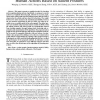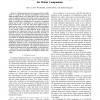76 search results - page 5 / 16 » Modeling and recognition of actions through motor primitives |
CVPR
2010
IEEE
14 years 4 months ago
2010
IEEE
A central problem in the analysis of motion capture (Mo-
Cap) data is how to decompose motion sequences into primitives.
Ideally, a description in terms of primitives should
fac...
TCSV
2008
13 years 8 months ago
2008
This paper presents a graphical model for learning and recognizing human actions. Specifically, we propose to encode actions in a weighted directed graph, referred to as action gra...
ICRA
2008
IEEE
14 years 3 months ago
2008
IEEE
— In this paper, we present an approach allowing a robot to learn a generative model of its own physical body from scratch using self-perception with a single monocular camera. O...
IROS
2007
IEEE
14 years 2 months ago
2007
IEEE
— This paper puts forward an approach for a mobile robot to recognize the human’s manipulative actions from different single camera views. While most of the related work in act...
WACV
2012
IEEE
12 years 4 months ago
2012
IEEE
Human movements are important cues for recognizing human actions, which can be captured by explicit modeling and tracking of actor or through space-time low-level features. Howeve...


